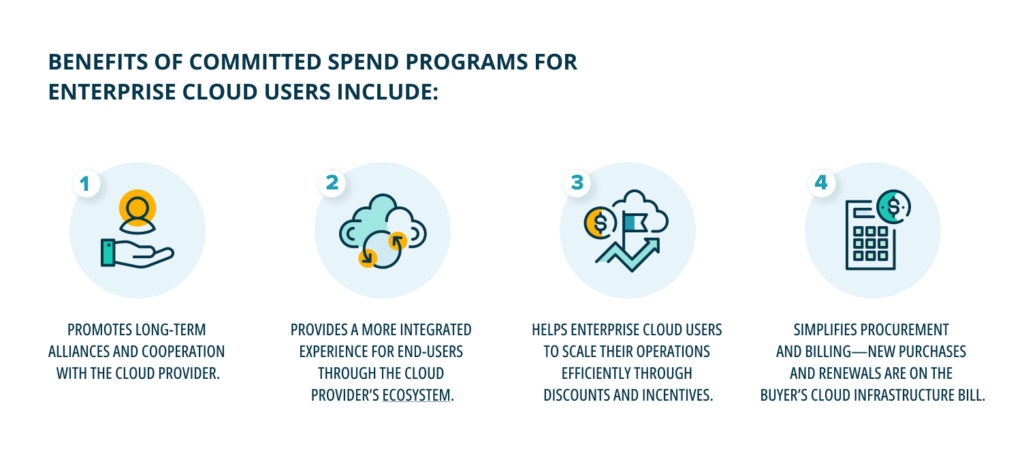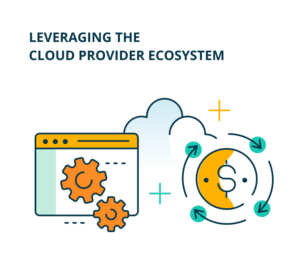Everything you need to know about cloud committed spend, cloud buyer enterprise agreements, and how to use them to your advantage
When it comes to selling software, a lot has changed over the past few years—with economic volatility being the most complicating factor. In the software industry, growth at all costs has given way to efficient growth in the face of economic turbulence, as companies look for stable, dependable sources of revenue just as budgets are tightening.
Yet it’s not all doom and gloom. The good news is that when it comes to cloud budgets, there are no signs of slowing down. According to Gartner, worldwide spending on public cloud services is forecast to reach nearly $600 billion in 2023. In fact, cloud spend is estimated to increase by 25-35% this year.
Read more: Cloud Marketplaces: An Even Keel in an Uncertain Economy
Accessing that budget is the top reason why buyers choose to purchase software via Cloud Marketplaces: Tackle’s State of Cloud Marketplaces Report says that 48% of respondents cite drawing down on committed cloud spend with Cloud Providers as the number one reason to make software purchases via Cloud Marketplaces.
Companies with committed cloud spend are looking for ways to optimize that budget, and have a real incentive to purchase third-party software in order to “burn down” committed spend with the Cloud Providers. This represents a significant opportunity for ISVs to leverage it to their advantage.
Here is a quick rundown on the basics of committed spend and how it works.

What is committed spend?
In the simplest terms, committed spend is when an organization contracts with a Cloud Provider for a level of cloud usage over a certain period of time. Generally speaking, these agreements are “use it or lose it.”
By and large, it works like this: an organization (the cloud customer) agrees to spend a minimum amount of money with a Cloud Provider for cloud services in exchange for discounted pricing on these services. These contracts typically come with a specified time frame during which the organization must “burn through” its commitment.
Benefits of committed spend programs for enterprise cloud users include:
- Promotes long-term alliances and cooperation with the Cloud Provider.
- Provides a more integrated experience for end-users through the Cloud Provider’s ecosystem.
- Helps enterprise cloud users to scale their operations efficiently through discounts and incentives.
- Simplifies procurement and billing—new purchases and renewals are on the buyer’s cloud infrastructure bill.
The three hyperscalers — Amazon Web Services (AWS), Google Cloud, and Microsoft — have their own versions of committed spend programs. Specific requirements, eligibility, and details vary, but here is a general overview of each program:
Amazon Enterprise Discount Program (EDP)
The Amazon Web Services Enterprise Discount Program (EDP) is tailored for enterprise cloud users with a demonstrated high commitment history. To be eligible for AWS EDP, customers must demonstrate a history of spending $1 million or more on AWS services or commit to doing so.
Google Cloud Committed Use Discounts (CUD)
Google’s Committed Use Discounts (CUD) provide discounted prices in exchange for a commitment to use a minimum level of resources for a specified term, usually a one- or three-year period. The discounts are flexible, cover a wide range of resources, and are ideal for workloads with predictable resource needs. Google offers discounts based on both “spend-based” commitments and “resource-based” commitments.
Microsoft Azure Consumption Commitment (MACC)
The “MACC” program allows enterprise customers to spend down Azure cloud commitment to Microsoft by purchasing third-party software and services through a transactable listing in Microsoft commercial marketplace. The MACC program creates a strong incentive for buyers to drive transactions through Microsoft commercial marketplace.
Leveraging committed spend for new business
This is all well and good for enterprise-level cloud customers, as well as the hyperscalers, but what does this mean for ISVs?
Committed spend represents a deep pool of untapped budget. Large organizations have already committed sizable amounts to the Cloud Providers—and many of them have done so in the years preceding recent economic volatility—and they may still need to burn down significant portions of that commitment. For sellers, this represents a prime opportunity to expand new business and land deals.
This was the case for CircleCI. “Marketplaces are becoming the go-to mechanism for procurement because customers commit to cloud spend and the more they spend, the larger discount they get,” said Larenzo Goodman, Senior Manager, Resellers, Cloud Alliances and Marketplace Partnerships at CircleCI. “We’ve seen a lot of our customers look across their stacks to see what they can obtain through a Marketplace to increase their cloud spend.”
That’s why it’s critical to lean on data to identify which Marketplaces your prospects are most likely to transact on, and which prospects have existing cloud budgets that can be used to purchase third-party software. There’s no room (and no need) for guesswork.
Read more: Leveraging Tackle Prospect to Identify the Right Buyers
Knowing how to talk to your buyer about committed cloud spend matters, too. Asking discovery questions will ensure that you are speaking to the right people at the right time, and save a lot of frustration for both you and the buyer.
Larger companies may have tightened their purse strings and are hesitant to purchase software in the current economic climate, but accessing their committed spend can be a real game changer when attempting to make a sale. If you’ve ever had a deal go sideways due to budget constraints, helping your buyer find a path to their cloud budget as an option can sometimes swing the deal in your favor.
Leveraging committed spend for contract renewals and upgrades
 Because committed spend is essentially a pool of usable budget, it’s tailor-made for contract renewals and upgrades, and can be leveraged to help close deals when it matters most.
Because committed spend is essentially a pool of usable budget, it’s tailor-made for contract renewals and upgrades, and can be leveraged to help close deals when it matters most.
Organizations that dig in their heels when it comes to software upgrades, or balk at renewals during an economic downturn, might reconsider when provided the option to apply the purchase to their cloud budget. It’s a quick and painless mechanism for pushing renewals over the finish line.
What’s more, tapping into an organization’s cloud budget provides an extra layer of “stickiness:” because the renewal was seamless and integrated into their cloud bill, that customer is less likely to churn.
Leveraging the Cloud Provider ecosystem
Cloud Providers will sometimes offer extra cloud commit credits (most often in the form of infrastructure credits) to companies making software purchases that enhance the CP’s ecosystem. In other words, if your product pairs well with the Cloud Provider’s ecosystem and will help drive cloud consumption, the Cloud Provider may be willing to offer credits to the buyer to help offset the cost of the purchase. 
This type of arrangement is by no means guaranteed, but it may be worth exploring, and could certainly sweeten the deal to make all the difference in a potential sale.
In a similar vein, ISVs can leverage their own integration with the CP’s ecosystem as a tool to sweeten a deal. For example, as an organization begins to budget for third-party software purchases in the growth of their cloud commit, it may be advantageous to emphasize your product’s integration with the CP as a way for the buyer to more strategically align with the Cloud Provider by purchasing your product.
Next steps
Accessing committed spend is an excellent pathway for your buyers to transact quickly and easily through the clouds. It’s a solid step toward building a Cloud GTM strategy that drives strategic growth, regardless of current economic conditions.
It’s also important to note that knowing who is purchasing on the clouds, and where they are purchasing, is paramount to building a data-driven sales strategy that can take full advantage of cloud commitments, whether its Amazon’s EDP, Google’s CUD, or Microsoft’s MACC. Having the right tools can go a long way toward unlocking the potential of Cloud GTM to reach even more buyers and their cloud budgets.

